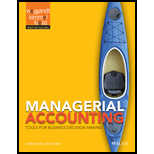
Concept explainers
Curtis Rich, the cost accountant for Hi-Power Mower Company, recently installed activity- based costing at Hi-Power's St. Louis lawn tractor (riding mower) plant where three models—the 8-horsepower Bladerunner, the 12-horsepower Quickcut, and the 18-horsepower Supercut—are manufactured. Curtis's new product costs for these three models show that the company's traditional costing system had been significantly undercosting the 18-horsepower Supercut. This was due primarily to the lower sales volume of the Supercut compared to the Bladerunner and the Quickcut.
Before completing his analysis and reporting these results to management. Curtis is approached by his friend Ed Gray, who is the production manager for the 18-horsepower Supercut model. Ed has heard from one of Curtis's staff about the new product costs and is upset and worried for his job because the new costs show the Supercut to be losing, rather than making, money.
At first, Ed condemns the new cost system, where upon Curtis explains the practice of activity-based costing and why it is more accurate than the company's present system. Even more worried now, Ed begs Curtis, “Massage the figures just enough to save the line from being discontinued. You don't want me to lose my job, do you? Anyway, nobody will know.”
Curtis holds firm but agrees to recompute all his calculations for accuracy before submitting his costs to management.
Instructions
(a) Who are the stakeholders in this situation?
(b) What, if any. are the ethical considerations in this situation?
(c) What are Curtis's ethical obligations to the company? To his friend?
Want to see the full answer?
Check out a sample textbook solution
Chapter 4 Solutions
Managerial Accounting: Tools for Business Decision Making
Additional Business Textbook Solutions
Corporate Finance (4th Edition) (Pearson Series in Finance) - Standalone book
Operations Management
Financial Accounting: Tools for Business Decision Making, 8th Edition
Marketing: An Introduction (13th Edition)
Financial Accounting (12th Edition) (What's New in Accounting)
Foundations Of Finance
- Financial Accountingarrow_forwardMason (single) is a 50 percent shareholder in Angels Corporation (an S Corporation). Mason receives a $184,500 salary working full time for Angels Corporation. Angels Corporation reported $418,000 of taxable business income for the year. Before considering his business income allocation from Angels and the self-employment tax deduction (if any), Mason's adjusted gross income is $184,500 (all salary from Angels Corporation). Mason claims $59,000 in itemized deductions. Answer the following questions for Mason. c. b. Assuming the business income allocated to Mason is income from a specified service trade or business, except that Angels Corporation reported $168,000 of taxable business income for the year. What is Mason's deduction for qualified business income? Ignore the wage-based limitation when computing the deduction.arrow_forwardPlease give me true answer this financial accounting questionarrow_forward
 Cornerstones of Cost Management (Cornerstones Ser...AccountingISBN:9781305970663Author:Don R. Hansen, Maryanne M. MowenPublisher:Cengage Learning
Cornerstones of Cost Management (Cornerstones Ser...AccountingISBN:9781305970663Author:Don R. Hansen, Maryanne M. MowenPublisher:Cengage Learning Principles of Cost AccountingAccountingISBN:9781305087408Author:Edward J. Vanderbeck, Maria R. MitchellPublisher:Cengage Learning
Principles of Cost AccountingAccountingISBN:9781305087408Author:Edward J. Vanderbeck, Maria R. MitchellPublisher:Cengage Learning Managerial AccountingAccountingISBN:9781337912020Author:Carl Warren, Ph.d. Cma William B. TaylerPublisher:South-Western College Pub
Managerial AccountingAccountingISBN:9781337912020Author:Carl Warren, Ph.d. Cma William B. TaylerPublisher:South-Western College Pub Financial And Managerial AccountingAccountingISBN:9781337902663Author:WARREN, Carl S.Publisher:Cengage Learning,
Financial And Managerial AccountingAccountingISBN:9781337902663Author:WARREN, Carl S.Publisher:Cengage Learning,



